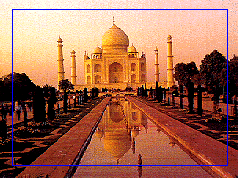Taj Mahal
Islamic architecture, in its purest form, is epitomized by the incomparable Taj Mahal built by the Mughal Emperor Shahjahan as a memorial to his wife, Mumtaz Mahal. Work started on this monument in 1634 and continued for almost 22 years. Situated in the city of Agra on the banks of the Yamuna, the Taj is enclosed in a garden amidst fountains and ornamental trees. The walled complex includes two mosques and an imposing gateway. The tomb is encased in white marble which is decorated with flawless sculptures and inlaid design of flowers and calligraphy cut from precious gems. Below the dome, in a dimly lit chamber, lie the mortal remains of Shahjahan and his beloved queen Mumtaz Mahal, reminding the world of their undying love. The silver light of the full moon shines upon the cool white dome of the Taj Mahal, softly glowing in the night air. The extreme magnificence and beauty of the Taj can be appreciated fully in the subtle moonlight. However, the radiance of dawn and the orange glow of sunset also illumine the splendor of this most beautiful monument of India. Even in the bright light of the day, this wonder of the world shines with an awe-inspiring loveliness. Without doubt, the Taj Mahal ranks as amongst the most perfect buildings in the world, flawlessly proportionate, built entirely out of marble. Intended to be a commemoration of the memory of Shahjahan's beloved wife, in reality, it is his gift to the entire human race. |
